Influencing Organizational Culture and Change
VerifiedAdded on 2023/06/14
|12
|3487
|396
AI Summary
This article discusses the importance of organizational culture and change management. It covers the theories and models of change management, including individual and organizational change management. The role of management in influencing change is also explored, along with recommendations for cultural change management.
Contribute Materials
Your contribution can guide someone’s learning journey. Share your
documents today.
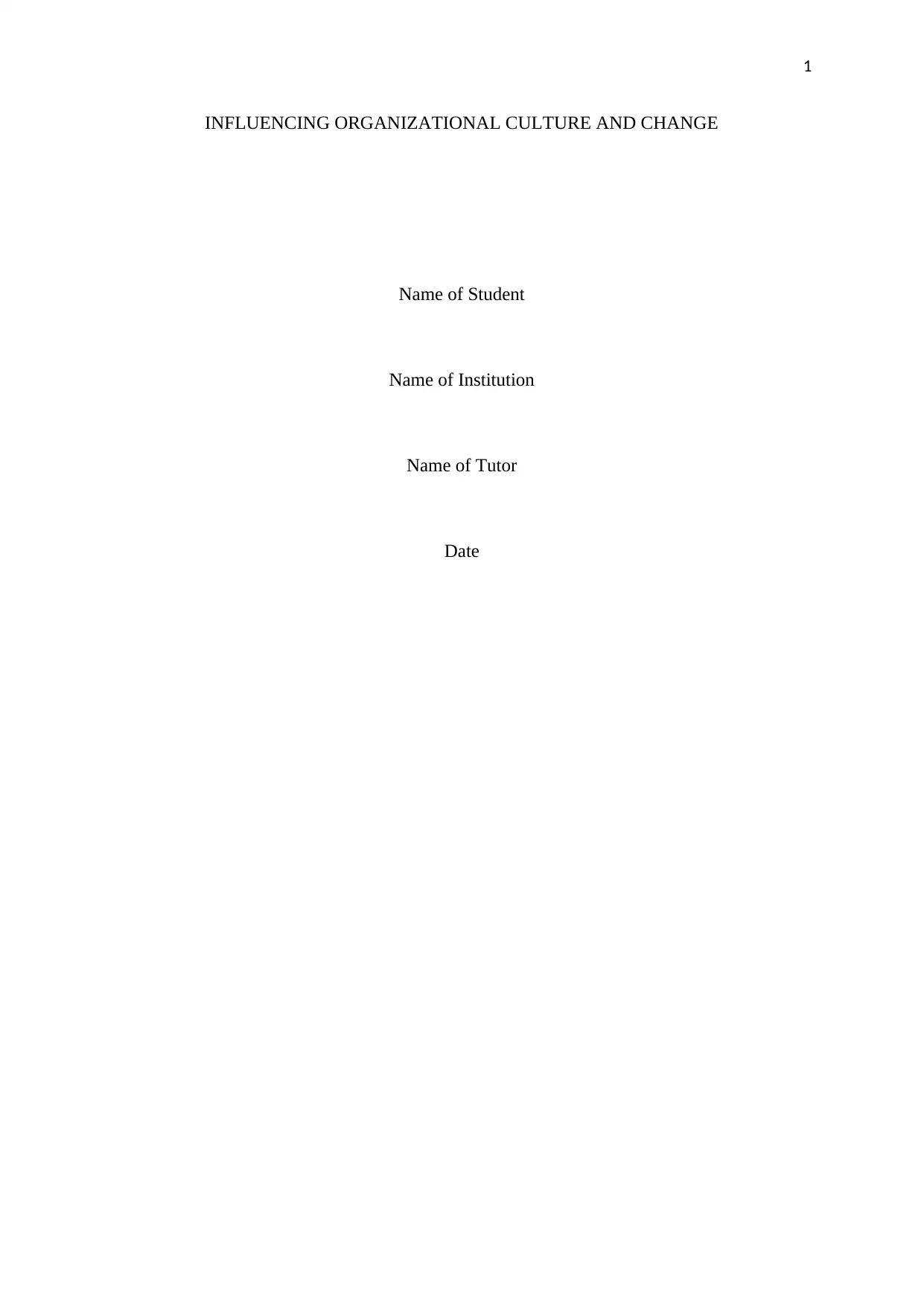
1
INFLUENCING ORGANIZATIONAL CULTURE AND CHANGE
Name of Student
Name of Institution
Name of Tutor
Date
INFLUENCING ORGANIZATIONAL CULTURE AND CHANGE
Name of Student
Name of Institution
Name of Tutor
Date
Secure Best Marks with AI Grader
Need help grading? Try our AI Grader for instant feedback on your assignments.
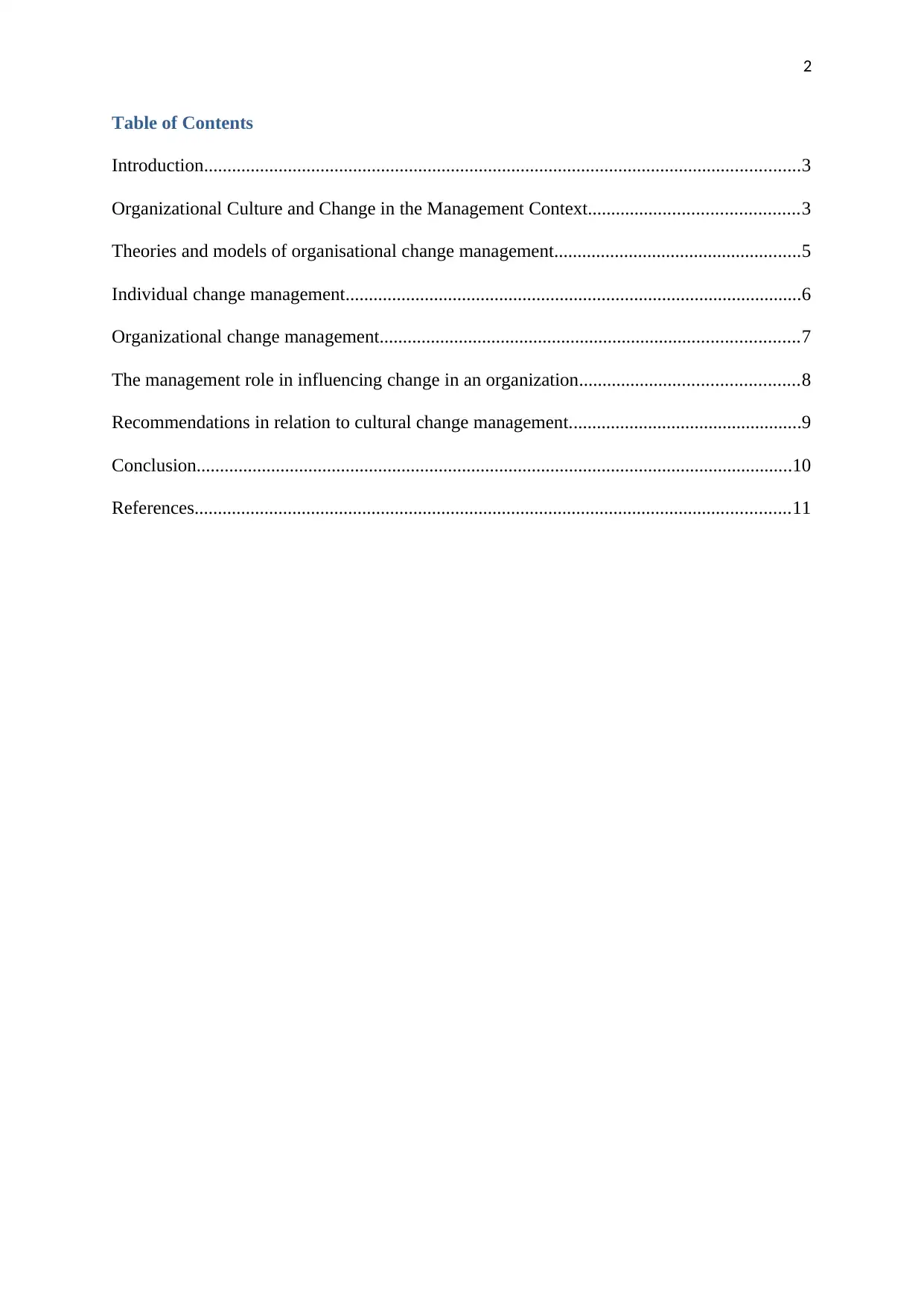
2
Table of Contents
Introduction................................................................................................................................3
Organizational Culture and Change in the Management Context.............................................3
Theories and models of organisational change management.....................................................5
Individual change management..................................................................................................6
Organizational change management..........................................................................................7
The management role in influencing change in an organization...............................................8
Recommendations in relation to cultural change management..................................................9
Conclusion................................................................................................................................10
References................................................................................................................................11
Table of Contents
Introduction................................................................................................................................3
Organizational Culture and Change in the Management Context.............................................3
Theories and models of organisational change management.....................................................5
Individual change management..................................................................................................6
Organizational change management..........................................................................................7
The management role in influencing change in an organization...............................................8
Recommendations in relation to cultural change management..................................................9
Conclusion................................................................................................................................10
References................................................................................................................................11
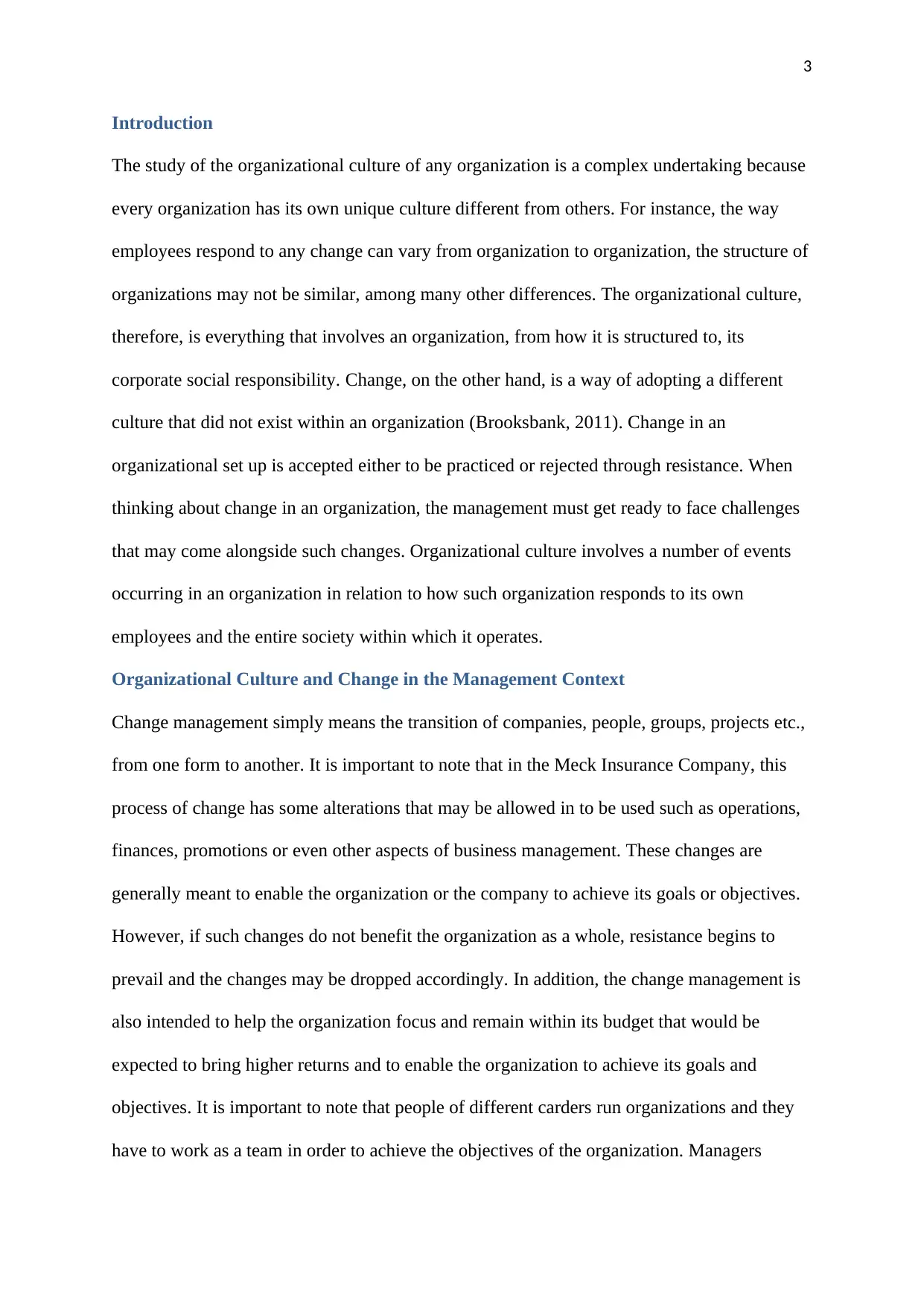
3
Introduction
The study of the organizational culture of any organization is a complex undertaking because
every organization has its own unique culture different from others. For instance, the way
employees respond to any change can vary from organization to organization, the structure of
organizations may not be similar, among many other differences. The organizational culture,
therefore, is everything that involves an organization, from how it is structured to, its
corporate social responsibility. Change, on the other hand, is a way of adopting a different
culture that did not exist within an organization (Brooksbank, 2011). Change in an
organizational set up is accepted either to be practiced or rejected through resistance. When
thinking about change in an organization, the management must get ready to face challenges
that may come alongside such changes. Organizational culture involves a number of events
occurring in an organization in relation to how such organization responds to its own
employees and the entire society within which it operates.
Organizational Culture and Change in the Management Context
Change management simply means the transition of companies, people, groups, projects etc.,
from one form to another. It is important to note that in the Meck Insurance Company, this
process of change has some alterations that may be allowed in to be used such as operations,
finances, promotions or even other aspects of business management. These changes are
generally meant to enable the organization or the company to achieve its goals or objectives.
However, if such changes do not benefit the organization as a whole, resistance begins to
prevail and the changes may be dropped accordingly. In addition, the change management is
also intended to help the organization focus and remain within its budget that would be
expected to bring higher returns and to enable the organization to achieve its goals and
objectives. It is important to note that people of different carders run organizations and they
have to work as a team in order to achieve the objectives of the organization. Managers
Introduction
The study of the organizational culture of any organization is a complex undertaking because
every organization has its own unique culture different from others. For instance, the way
employees respond to any change can vary from organization to organization, the structure of
organizations may not be similar, among many other differences. The organizational culture,
therefore, is everything that involves an organization, from how it is structured to, its
corporate social responsibility. Change, on the other hand, is a way of adopting a different
culture that did not exist within an organization (Brooksbank, 2011). Change in an
organizational set up is accepted either to be practiced or rejected through resistance. When
thinking about change in an organization, the management must get ready to face challenges
that may come alongside such changes. Organizational culture involves a number of events
occurring in an organization in relation to how such organization responds to its own
employees and the entire society within which it operates.
Organizational Culture and Change in the Management Context
Change management simply means the transition of companies, people, groups, projects etc.,
from one form to another. It is important to note that in the Meck Insurance Company, this
process of change has some alterations that may be allowed in to be used such as operations,
finances, promotions or even other aspects of business management. These changes are
generally meant to enable the organization or the company to achieve its goals or objectives.
However, if such changes do not benefit the organization as a whole, resistance begins to
prevail and the changes may be dropped accordingly. In addition, the change management is
also intended to help the organization focus and remain within its budget that would be
expected to bring higher returns and to enable the organization to achieve its goals and
objectives. It is important to note that people of different carders run organizations and they
have to work as a team in order to achieve the objectives of the organization. Managers
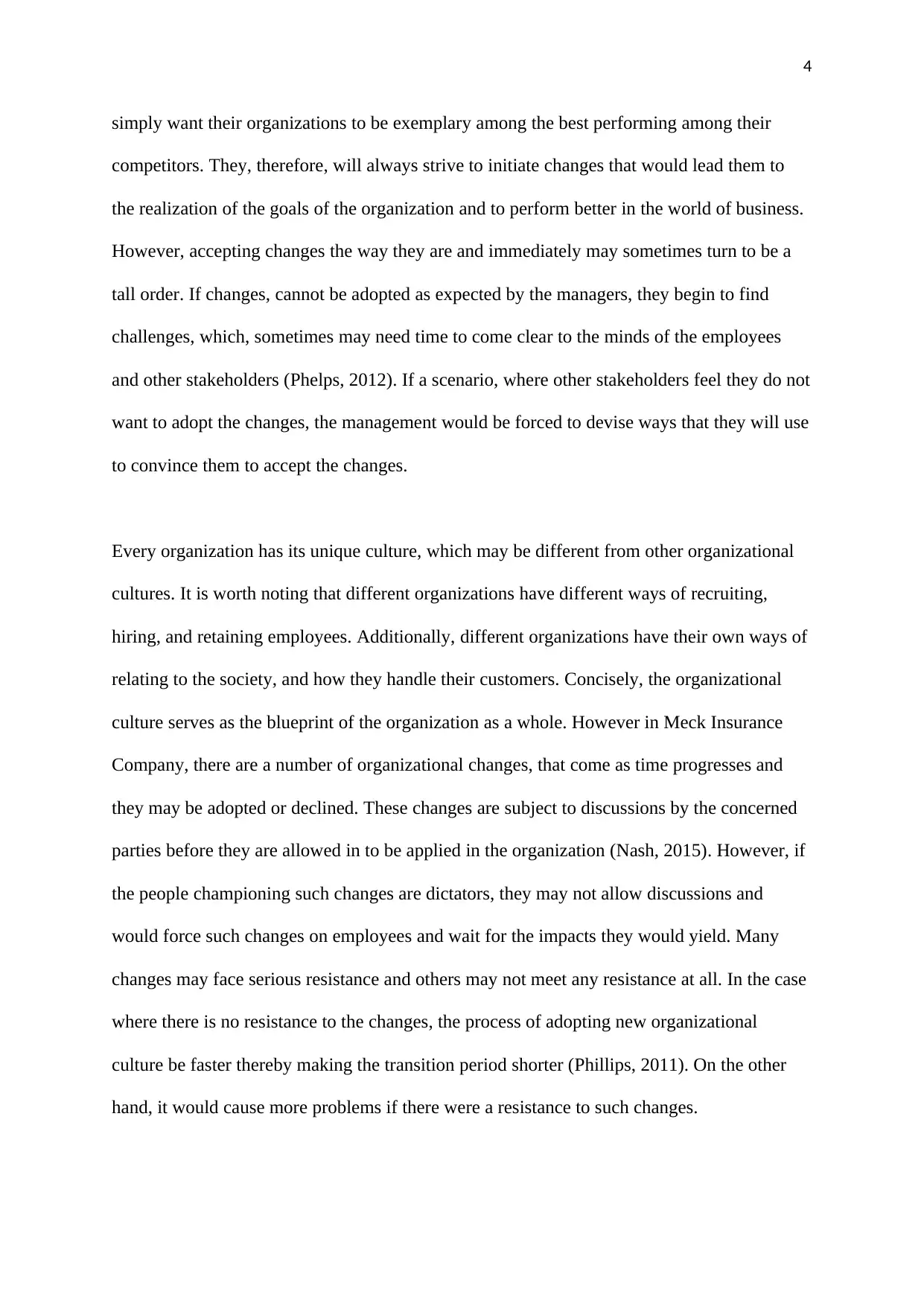
4
simply want their organizations to be exemplary among the best performing among their
competitors. They, therefore, will always strive to initiate changes that would lead them to
the realization of the goals of the organization and to perform better in the world of business.
However, accepting changes the way they are and immediately may sometimes turn to be a
tall order. If changes, cannot be adopted as expected by the managers, they begin to find
challenges, which, sometimes may need time to come clear to the minds of the employees
and other stakeholders (Phelps, 2012). If a scenario, where other stakeholders feel they do not
want to adopt the changes, the management would be forced to devise ways that they will use
to convince them to accept the changes.
Every organization has its unique culture, which may be different from other organizational
cultures. It is worth noting that different organizations have different ways of recruiting,
hiring, and retaining employees. Additionally, different organizations have their own ways of
relating to the society, and how they handle their customers. Concisely, the organizational
culture serves as the blueprint of the organization as a whole. However in Meck Insurance
Company, there are a number of organizational changes, that come as time progresses and
they may be adopted or declined. These changes are subject to discussions by the concerned
parties before they are allowed in to be applied in the organization (Nash, 2015). However, if
the people championing such changes are dictators, they may not allow discussions and
would force such changes on employees and wait for the impacts they would yield. Many
changes may face serious resistance and others may not meet any resistance at all. In the case
where there is no resistance to the changes, the process of adopting new organizational
culture be faster thereby making the transition period shorter (Phillips, 2011). On the other
hand, it would cause more problems if there were a resistance to such changes.
simply want their organizations to be exemplary among the best performing among their
competitors. They, therefore, will always strive to initiate changes that would lead them to
the realization of the goals of the organization and to perform better in the world of business.
However, accepting changes the way they are and immediately may sometimes turn to be a
tall order. If changes, cannot be adopted as expected by the managers, they begin to find
challenges, which, sometimes may need time to come clear to the minds of the employees
and other stakeholders (Phelps, 2012). If a scenario, where other stakeholders feel they do not
want to adopt the changes, the management would be forced to devise ways that they will use
to convince them to accept the changes.
Every organization has its unique culture, which may be different from other organizational
cultures. It is worth noting that different organizations have different ways of recruiting,
hiring, and retaining employees. Additionally, different organizations have their own ways of
relating to the society, and how they handle their customers. Concisely, the organizational
culture serves as the blueprint of the organization as a whole. However in Meck Insurance
Company, there are a number of organizational changes, that come as time progresses and
they may be adopted or declined. These changes are subject to discussions by the concerned
parties before they are allowed in to be applied in the organization (Nash, 2015). However, if
the people championing such changes are dictators, they may not allow discussions and
would force such changes on employees and wait for the impacts they would yield. Many
changes may face serious resistance and others may not meet any resistance at all. In the case
where there is no resistance to the changes, the process of adopting new organizational
culture be faster thereby making the transition period shorter (Phillips, 2011). On the other
hand, it would cause more problems if there were a resistance to such changes.
Secure Best Marks with AI Grader
Need help grading? Try our AI Grader for instant feedback on your assignments.
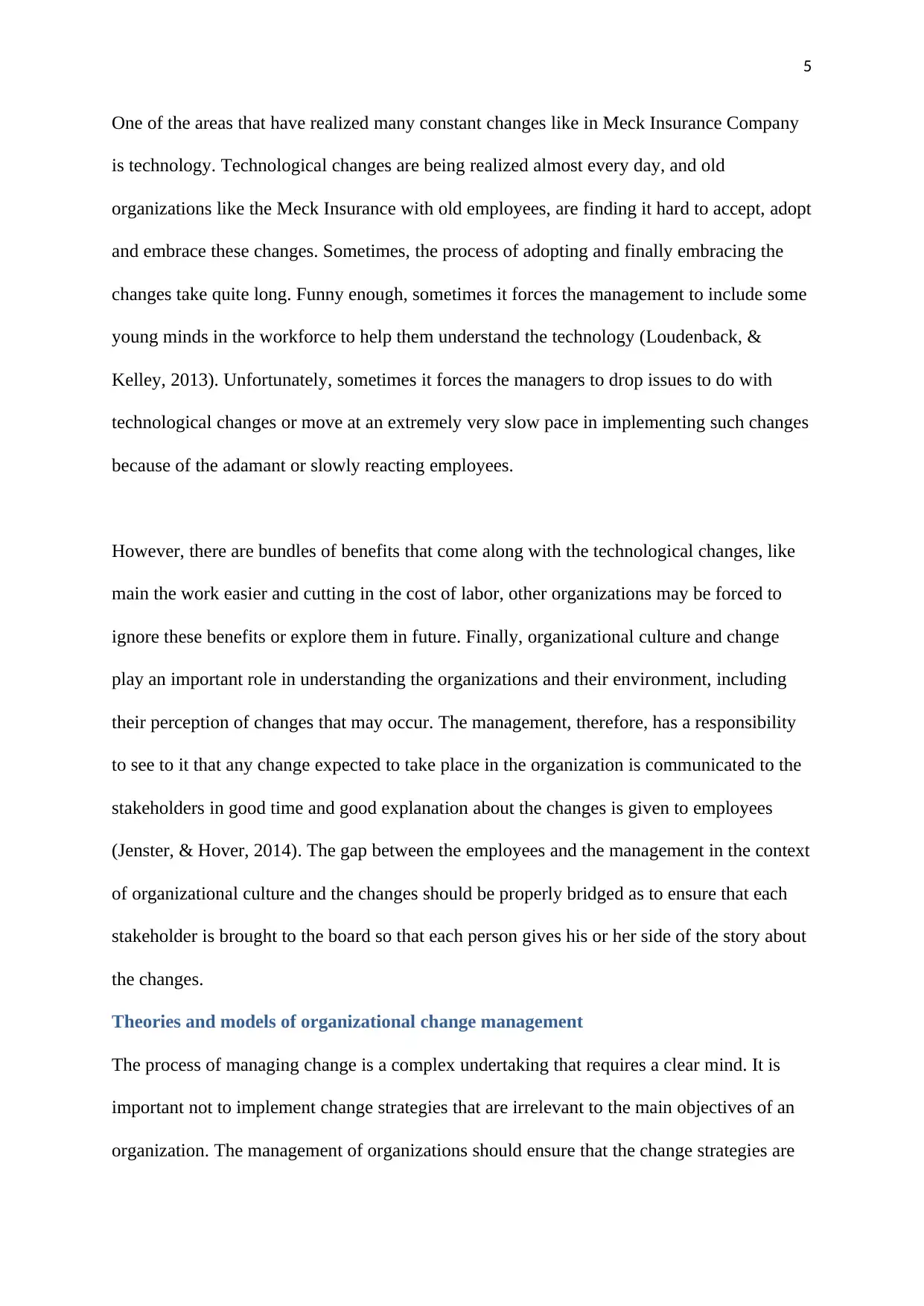
5
One of the areas that have realized many constant changes like in Meck Insurance Company
is technology. Technological changes are being realized almost every day, and old
organizations like the Meck Insurance with old employees, are finding it hard to accept, adopt
and embrace these changes. Sometimes, the process of adopting and finally embracing the
changes take quite long. Funny enough, sometimes it forces the management to include some
young minds in the workforce to help them understand the technology (Loudenback, &
Kelley, 2013). Unfortunately, sometimes it forces the managers to drop issues to do with
technological changes or move at an extremely very slow pace in implementing such changes
because of the adamant or slowly reacting employees.
However, there are bundles of benefits that come along with the technological changes, like
main the work easier and cutting in the cost of labor, other organizations may be forced to
ignore these benefits or explore them in future. Finally, organizational culture and change
play an important role in understanding the organizations and their environment, including
their perception of changes that may occur. The management, therefore, has a responsibility
to see to it that any change expected to take place in the organization is communicated to the
stakeholders in good time and good explanation about the changes is given to employees
(Jenster, & Hover, 2014). The gap between the employees and the management in the context
of organizational culture and the changes should be properly bridged as to ensure that each
stakeholder is brought to the board so that each person gives his or her side of the story about
the changes.
Theories and models of organizational change management
The process of managing change is a complex undertaking that requires a clear mind. It is
important not to implement change strategies that are irrelevant to the main objectives of an
organization. The management of organizations should ensure that the change strategies are
One of the areas that have realized many constant changes like in Meck Insurance Company
is technology. Technological changes are being realized almost every day, and old
organizations like the Meck Insurance with old employees, are finding it hard to accept, adopt
and embrace these changes. Sometimes, the process of adopting and finally embracing the
changes take quite long. Funny enough, sometimes it forces the management to include some
young minds in the workforce to help them understand the technology (Loudenback, &
Kelley, 2013). Unfortunately, sometimes it forces the managers to drop issues to do with
technological changes or move at an extremely very slow pace in implementing such changes
because of the adamant or slowly reacting employees.
However, there are bundles of benefits that come along with the technological changes, like
main the work easier and cutting in the cost of labor, other organizations may be forced to
ignore these benefits or explore them in future. Finally, organizational culture and change
play an important role in understanding the organizations and their environment, including
their perception of changes that may occur. The management, therefore, has a responsibility
to see to it that any change expected to take place in the organization is communicated to the
stakeholders in good time and good explanation about the changes is given to employees
(Jenster, & Hover, 2014). The gap between the employees and the management in the context
of organizational culture and the changes should be properly bridged as to ensure that each
stakeholder is brought to the board so that each person gives his or her side of the story about
the changes.
Theories and models of organizational change management
The process of managing change is a complex undertaking that requires a clear mind. It is
important not to implement change strategies that are irrelevant to the main objectives of an
organization. The management of organizations should ensure that the change strategies are
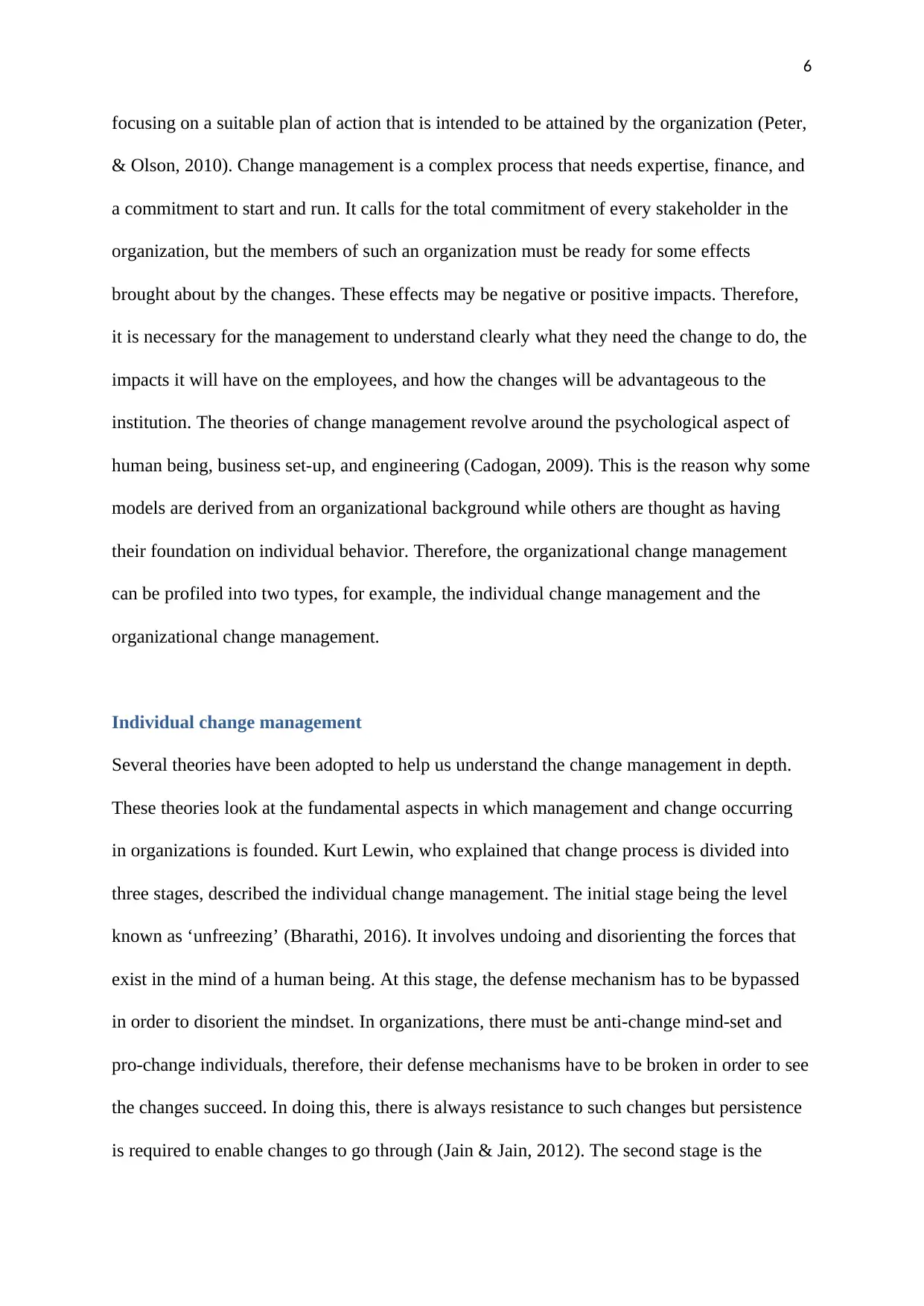
6
focusing on a suitable plan of action that is intended to be attained by the organization (Peter,
& Olson, 2010). Change management is a complex process that needs expertise, finance, and
a commitment to start and run. It calls for the total commitment of every stakeholder in the
organization, but the members of such an organization must be ready for some effects
brought about by the changes. These effects may be negative or positive impacts. Therefore,
it is necessary for the management to understand clearly what they need the change to do, the
impacts it will have on the employees, and how the changes will be advantageous to the
institution. The theories of change management revolve around the psychological aspect of
human being, business set-up, and engineering (Cadogan, 2009). This is the reason why some
models are derived from an organizational background while others are thought as having
their foundation on individual behavior. Therefore, the organizational change management
can be profiled into two types, for example, the individual change management and the
organizational change management.
Individual change management
Several theories have been adopted to help us understand the change management in depth.
These theories look at the fundamental aspects in which management and change occurring
in organizations is founded. Kurt Lewin, who explained that change process is divided into
three stages, described the individual change management. The initial stage being the level
known as ‘unfreezing’ (Bharathi, 2016). It involves undoing and disorienting the forces that
exist in the mind of a human being. At this stage, the defense mechanism has to be bypassed
in order to disorient the mindset. In organizations, there must be anti-change mind-set and
pro-change individuals, therefore, their defense mechanisms have to be broken in order to see
the changes succeed. In doing this, there is always resistance to such changes but persistence
is required to enable changes to go through (Jain & Jain, 2012). The second stage is the
focusing on a suitable plan of action that is intended to be attained by the organization (Peter,
& Olson, 2010). Change management is a complex process that needs expertise, finance, and
a commitment to start and run. It calls for the total commitment of every stakeholder in the
organization, but the members of such an organization must be ready for some effects
brought about by the changes. These effects may be negative or positive impacts. Therefore,
it is necessary for the management to understand clearly what they need the change to do, the
impacts it will have on the employees, and how the changes will be advantageous to the
institution. The theories of change management revolve around the psychological aspect of
human being, business set-up, and engineering (Cadogan, 2009). This is the reason why some
models are derived from an organizational background while others are thought as having
their foundation on individual behavior. Therefore, the organizational change management
can be profiled into two types, for example, the individual change management and the
organizational change management.
Individual change management
Several theories have been adopted to help us understand the change management in depth.
These theories look at the fundamental aspects in which management and change occurring
in organizations is founded. Kurt Lewin, who explained that change process is divided into
three stages, described the individual change management. The initial stage being the level
known as ‘unfreezing’ (Bharathi, 2016). It involves undoing and disorienting the forces that
exist in the mind of a human being. At this stage, the defense mechanism has to be bypassed
in order to disorient the mindset. In organizations, there must be anti-change mind-set and
pro-change individuals, therefore, their defense mechanisms have to be broken in order to see
the changes succeed. In doing this, there is always resistance to such changes but persistence
is required to enable changes to go through (Jain & Jain, 2012). The second stage is the
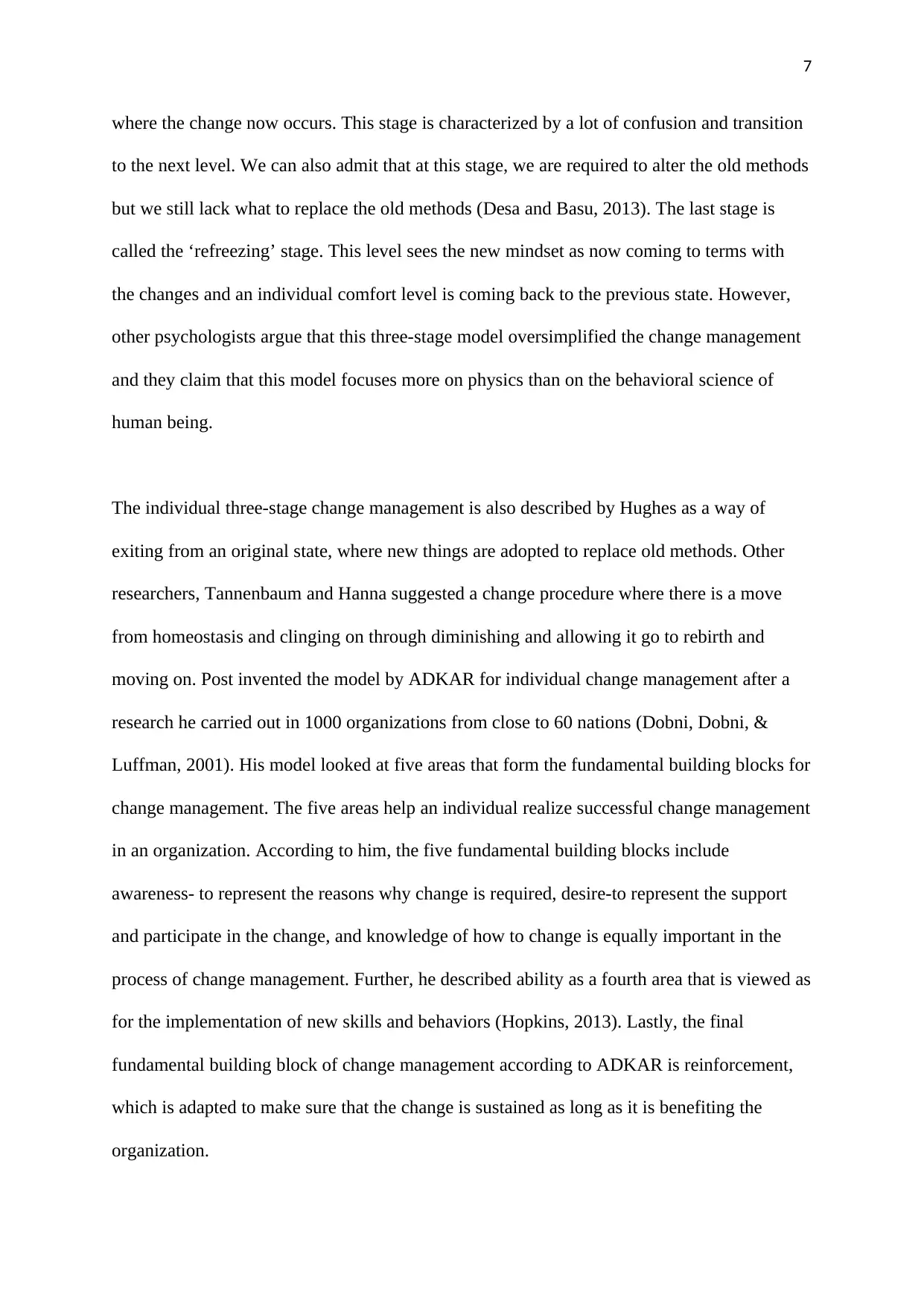
7
where the change now occurs. This stage is characterized by a lot of confusion and transition
to the next level. We can also admit that at this stage, we are required to alter the old methods
but we still lack what to replace the old methods (Desa and Basu, 2013). The last stage is
called the ‘refreezing’ stage. This level sees the new mindset as now coming to terms with
the changes and an individual comfort level is coming back to the previous state. However,
other psychologists argue that this three-stage model oversimplified the change management
and they claim that this model focuses more on physics than on the behavioral science of
human being.
The individual three-stage change management is also described by Hughes as a way of
exiting from an original state, where new things are adopted to replace old methods. Other
researchers, Tannenbaum and Hanna suggested a change procedure where there is a move
from homeostasis and clinging on through diminishing and allowing it go to rebirth and
moving on. Post invented the model by ADKAR for individual change management after a
research he carried out in 1000 organizations from close to 60 nations (Dobni, Dobni, &
Luffman, 2001). His model looked at five areas that form the fundamental building blocks for
change management. The five areas help an individual realize successful change management
in an organization. According to him, the five fundamental building blocks include
awareness- to represent the reasons why change is required, desire-to represent the support
and participate in the change, and knowledge of how to change is equally important in the
process of change management. Further, he described ability as a fourth area that is viewed as
for the implementation of new skills and behaviors (Hopkins, 2013). Lastly, the final
fundamental building block of change management according to ADKAR is reinforcement,
which is adapted to make sure that the change is sustained as long as it is benefiting the
organization.
where the change now occurs. This stage is characterized by a lot of confusion and transition
to the next level. We can also admit that at this stage, we are required to alter the old methods
but we still lack what to replace the old methods (Desa and Basu, 2013). The last stage is
called the ‘refreezing’ stage. This level sees the new mindset as now coming to terms with
the changes and an individual comfort level is coming back to the previous state. However,
other psychologists argue that this three-stage model oversimplified the change management
and they claim that this model focuses more on physics than on the behavioral science of
human being.
The individual three-stage change management is also described by Hughes as a way of
exiting from an original state, where new things are adopted to replace old methods. Other
researchers, Tannenbaum and Hanna suggested a change procedure where there is a move
from homeostasis and clinging on through diminishing and allowing it go to rebirth and
moving on. Post invented the model by ADKAR for individual change management after a
research he carried out in 1000 organizations from close to 60 nations (Dobni, Dobni, &
Luffman, 2001). His model looked at five areas that form the fundamental building blocks for
change management. The five areas help an individual realize successful change management
in an organization. According to him, the five fundamental building blocks include
awareness- to represent the reasons why change is required, desire-to represent the support
and participate in the change, and knowledge of how to change is equally important in the
process of change management. Further, he described ability as a fourth area that is viewed as
for the implementation of new skills and behaviors (Hopkins, 2013). Lastly, the final
fundamental building block of change management according to ADKAR is reinforcement,
which is adapted to make sure that the change is sustained as long as it is benefiting the
organization.
Paraphrase This Document
Need a fresh take? Get an instant paraphrase of this document with our AI Paraphraser
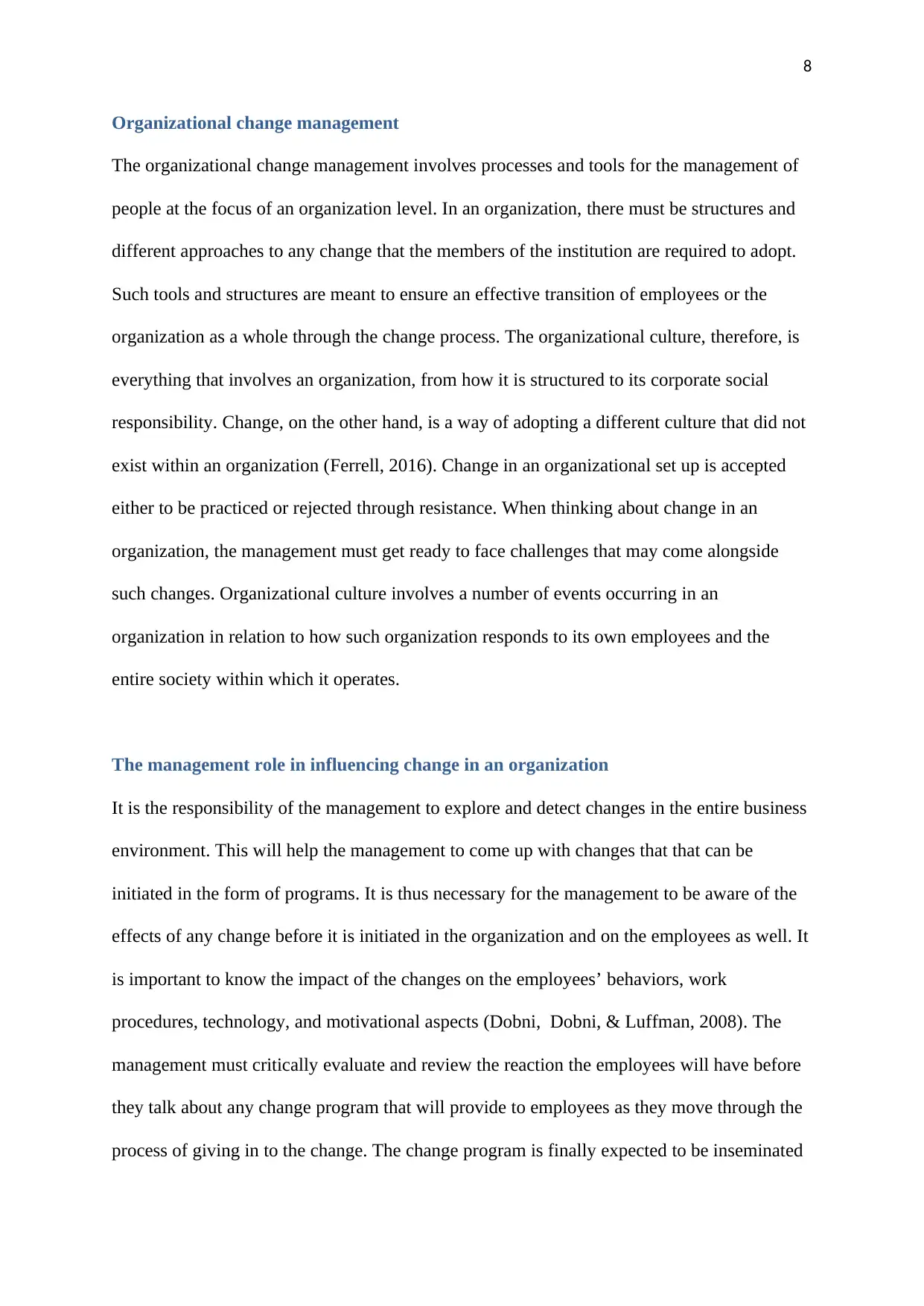
8
Organizational change management
The organizational change management involves processes and tools for the management of
people at the focus of an organization level. In an organization, there must be structures and
different approaches to any change that the members of the institution are required to adopt.
Such tools and structures are meant to ensure an effective transition of employees or the
organization as a whole through the change process. The organizational culture, therefore, is
everything that involves an organization, from how it is structured to its corporate social
responsibility. Change, on the other hand, is a way of adopting a different culture that did not
exist within an organization (Ferrell, 2016). Change in an organizational set up is accepted
either to be practiced or rejected through resistance. When thinking about change in an
organization, the management must get ready to face challenges that may come alongside
such changes. Organizational culture involves a number of events occurring in an
organization in relation to how such organization responds to its own employees and the
entire society within which it operates.
The management role in influencing change in an organization
It is the responsibility of the management to explore and detect changes in the entire business
environment. This will help the management to come up with changes that that can be
initiated in the form of programs. It is thus necessary for the management to be aware of the
effects of any change before it is initiated in the organization and on the employees as well. It
is important to know the impact of the changes on the employees’ behaviors, work
procedures, technology, and motivational aspects (Dobni, Dobni, & Luffman, 2008). The
management must critically evaluate and review the reaction the employees will have before
they talk about any change program that will provide to employees as they move through the
process of giving in to the change. The change program is finally expected to be inseminated
Organizational change management
The organizational change management involves processes and tools for the management of
people at the focus of an organization level. In an organization, there must be structures and
different approaches to any change that the members of the institution are required to adopt.
Such tools and structures are meant to ensure an effective transition of employees or the
organization as a whole through the change process. The organizational culture, therefore, is
everything that involves an organization, from how it is structured to its corporate social
responsibility. Change, on the other hand, is a way of adopting a different culture that did not
exist within an organization (Ferrell, 2016). Change in an organizational set up is accepted
either to be practiced or rejected through resistance. When thinking about change in an
organization, the management must get ready to face challenges that may come alongside
such changes. Organizational culture involves a number of events occurring in an
organization in relation to how such organization responds to its own employees and the
entire society within which it operates.
The management role in influencing change in an organization
It is the responsibility of the management to explore and detect changes in the entire business
environment. This will help the management to come up with changes that that can be
initiated in the form of programs. It is thus necessary for the management to be aware of the
effects of any change before it is initiated in the organization and on the employees as well. It
is important to know the impact of the changes on the employees’ behaviors, work
procedures, technology, and motivational aspects (Dobni, Dobni, & Luffman, 2008). The
management must critically evaluate and review the reaction the employees will have before
they talk about any change program that will provide to employees as they move through the
process of giving in to the change. The change program is finally expected to be inseminated
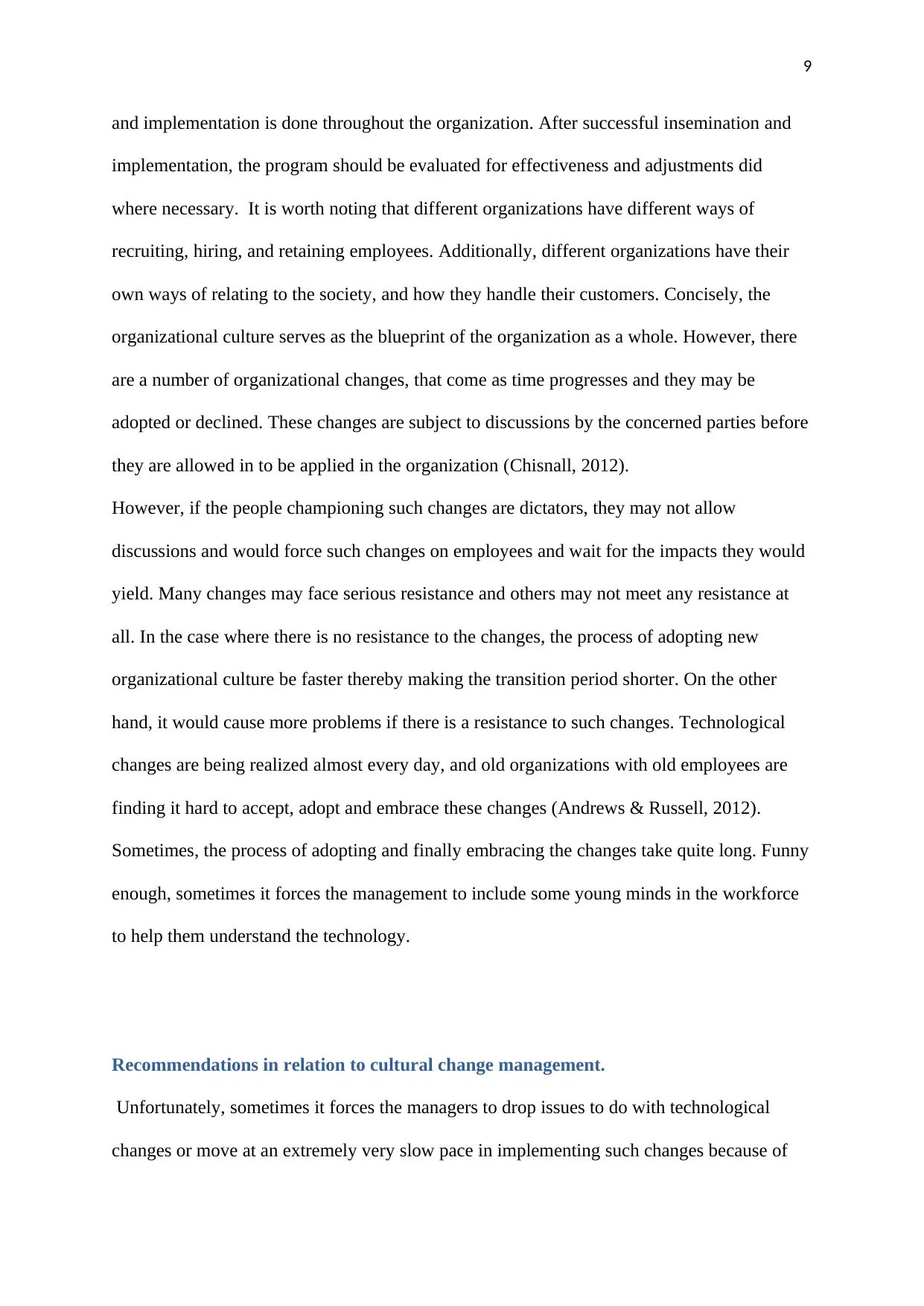
9
and implementation is done throughout the organization. After successful insemination and
implementation, the program should be evaluated for effectiveness and adjustments did
where necessary. It is worth noting that different organizations have different ways of
recruiting, hiring, and retaining employees. Additionally, different organizations have their
own ways of relating to the society, and how they handle their customers. Concisely, the
organizational culture serves as the blueprint of the organization as a whole. However, there
are a number of organizational changes, that come as time progresses and they may be
adopted or declined. These changes are subject to discussions by the concerned parties before
they are allowed in to be applied in the organization (Chisnall, 2012).
However, if the people championing such changes are dictators, they may not allow
discussions and would force such changes on employees and wait for the impacts they would
yield. Many changes may face serious resistance and others may not meet any resistance at
all. In the case where there is no resistance to the changes, the process of adopting new
organizational culture be faster thereby making the transition period shorter. On the other
hand, it would cause more problems if there is a resistance to such changes. Technological
changes are being realized almost every day, and old organizations with old employees are
finding it hard to accept, adopt and embrace these changes (Andrews & Russell, 2012).
Sometimes, the process of adopting and finally embracing the changes take quite long. Funny
enough, sometimes it forces the management to include some young minds in the workforce
to help them understand the technology.
Recommendations in relation to cultural change management.
Unfortunately, sometimes it forces the managers to drop issues to do with technological
changes or move at an extremely very slow pace in implementing such changes because of
and implementation is done throughout the organization. After successful insemination and
implementation, the program should be evaluated for effectiveness and adjustments did
where necessary. It is worth noting that different organizations have different ways of
recruiting, hiring, and retaining employees. Additionally, different organizations have their
own ways of relating to the society, and how they handle their customers. Concisely, the
organizational culture serves as the blueprint of the organization as a whole. However, there
are a number of organizational changes, that come as time progresses and they may be
adopted or declined. These changes are subject to discussions by the concerned parties before
they are allowed in to be applied in the organization (Chisnall, 2012).
However, if the people championing such changes are dictators, they may not allow
discussions and would force such changes on employees and wait for the impacts they would
yield. Many changes may face serious resistance and others may not meet any resistance at
all. In the case where there is no resistance to the changes, the process of adopting new
organizational culture be faster thereby making the transition period shorter. On the other
hand, it would cause more problems if there is a resistance to such changes. Technological
changes are being realized almost every day, and old organizations with old employees are
finding it hard to accept, adopt and embrace these changes (Andrews & Russell, 2012).
Sometimes, the process of adopting and finally embracing the changes take quite long. Funny
enough, sometimes it forces the management to include some young minds in the workforce
to help them understand the technology.
Recommendations in relation to cultural change management.
Unfortunately, sometimes it forces the managers to drop issues to do with technological
changes or move at an extremely very slow pace in implementing such changes because of
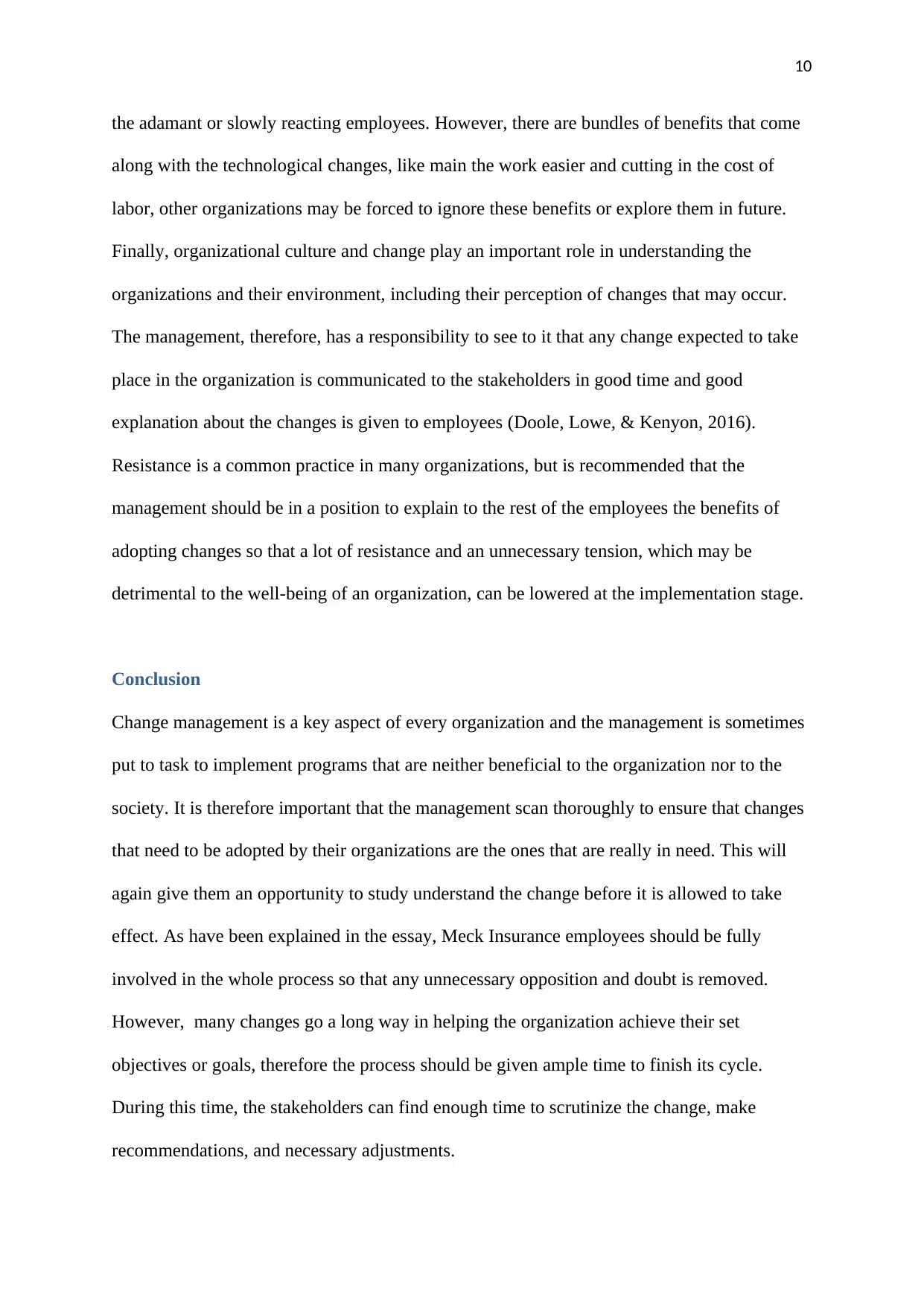
10
the adamant or slowly reacting employees. However, there are bundles of benefits that come
along with the technological changes, like main the work easier and cutting in the cost of
labor, other organizations may be forced to ignore these benefits or explore them in future.
Finally, organizational culture and change play an important role in understanding the
organizations and their environment, including their perception of changes that may occur.
The management, therefore, has a responsibility to see to it that any change expected to take
place in the organization is communicated to the stakeholders in good time and good
explanation about the changes is given to employees (Doole, Lowe, & Kenyon, 2016).
Resistance is a common practice in many organizations, but is recommended that the
management should be in a position to explain to the rest of the employees the benefits of
adopting changes so that a lot of resistance and an unnecessary tension, which may be
detrimental to the well-being of an organization, can be lowered at the implementation stage.
Conclusion
Change management is a key aspect of every organization and the management is sometimes
put to task to implement programs that are neither beneficial to the organization nor to the
society. It is therefore important that the management scan thoroughly to ensure that changes
that need to be adopted by their organizations are the ones that are really in need. This will
again give them an opportunity to study understand the change before it is allowed to take
effect. As have been explained in the essay, Meck Insurance employees should be fully
involved in the whole process so that any unnecessary opposition and doubt is removed.
However, many changes go a long way in helping the organization achieve their set
objectives or goals, therefore the process should be given ample time to finish its cycle.
During this time, the stakeholders can find enough time to scrutinize the change, make
recommendations, and necessary adjustments.
the adamant or slowly reacting employees. However, there are bundles of benefits that come
along with the technological changes, like main the work easier and cutting in the cost of
labor, other organizations may be forced to ignore these benefits or explore them in future.
Finally, organizational culture and change play an important role in understanding the
organizations and their environment, including their perception of changes that may occur.
The management, therefore, has a responsibility to see to it that any change expected to take
place in the organization is communicated to the stakeholders in good time and good
explanation about the changes is given to employees (Doole, Lowe, & Kenyon, 2016).
Resistance is a common practice in many organizations, but is recommended that the
management should be in a position to explain to the rest of the employees the benefits of
adopting changes so that a lot of resistance and an unnecessary tension, which may be
detrimental to the well-being of an organization, can be lowered at the implementation stage.
Conclusion
Change management is a key aspect of every organization and the management is sometimes
put to task to implement programs that are neither beneficial to the organization nor to the
society. It is therefore important that the management scan thoroughly to ensure that changes
that need to be adopted by their organizations are the ones that are really in need. This will
again give them an opportunity to study understand the change before it is allowed to take
effect. As have been explained in the essay, Meck Insurance employees should be fully
involved in the whole process so that any unnecessary opposition and doubt is removed.
However, many changes go a long way in helping the organization achieve their set
objectives or goals, therefore the process should be given ample time to finish its cycle.
During this time, the stakeholders can find enough time to scrutinize the change, make
recommendations, and necessary adjustments.
Secure Best Marks with AI Grader
Need help grading? Try our AI Grader for instant feedback on your assignments.
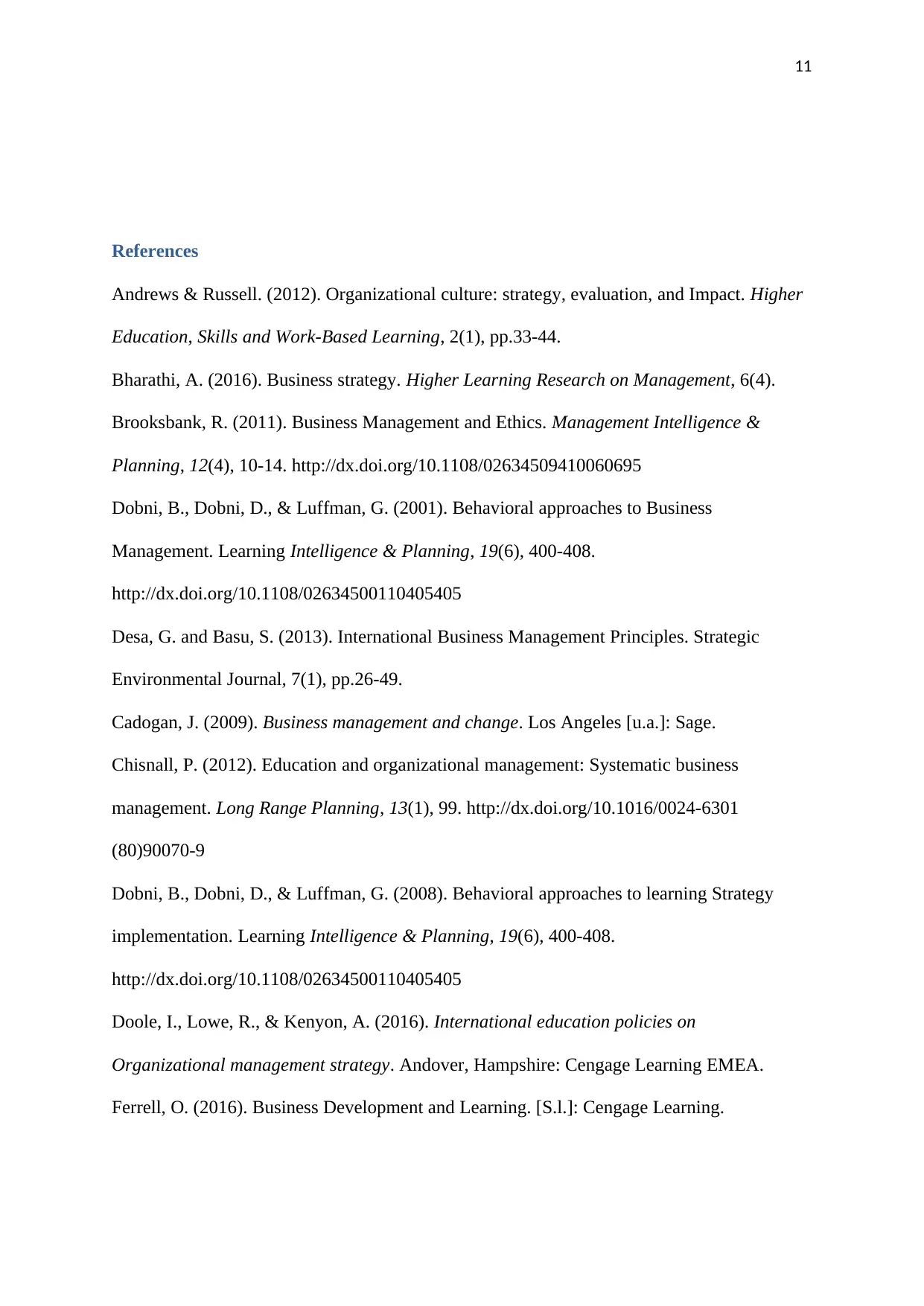
11
References
Andrews & Russell. (2012). Organizational culture: strategy, evaluation, and Impact. Higher
Education, Skills and Work-Based Learning, 2(1), pp.33-44.
Bharathi, A. (2016). Business strategy. Higher Learning Research on Management, 6(4).
Brooksbank, R. (2011). Business Management and Ethics. Management Intelligence &
Planning, 12(4), 10-14. http://dx.doi.org/10.1108/02634509410060695
Dobni, B., Dobni, D., & Luffman, G. (2001). Behavioral approaches to Business
Management. Learning Intelligence & Planning, 19(6), 400-408.
http://dx.doi.org/10.1108/02634500110405405
Desa, G. and Basu, S. (2013). International Business Management Principles. Strategic
Environmental Journal, 7(1), pp.26-49.
Cadogan, J. (2009). Business management and change. Los Angeles [u.a.]: Sage.
Chisnall, P. (2012). Education and organizational management: Systematic business
management. Long Range Planning, 13(1), 99. http://dx.doi.org/10.1016/0024-6301
(80)90070-9
Dobni, B., Dobni, D., & Luffman, G. (2008). Behavioral approaches to learning Strategy
implementation. Learning Intelligence & Planning, 19(6), 400-408.
http://dx.doi.org/10.1108/02634500110405405
Doole, I., Lowe, R., & Kenyon, A. (2016). International education policies on
Organizational management strategy. Andover, Hampshire: Cengage Learning EMEA.
Ferrell, O. (2016). Business Development and Learning. [S.l.]: Cengage Learning.
References
Andrews & Russell. (2012). Organizational culture: strategy, evaluation, and Impact. Higher
Education, Skills and Work-Based Learning, 2(1), pp.33-44.
Bharathi, A. (2016). Business strategy. Higher Learning Research on Management, 6(4).
Brooksbank, R. (2011). Business Management and Ethics. Management Intelligence &
Planning, 12(4), 10-14. http://dx.doi.org/10.1108/02634509410060695
Dobni, B., Dobni, D., & Luffman, G. (2001). Behavioral approaches to Business
Management. Learning Intelligence & Planning, 19(6), 400-408.
http://dx.doi.org/10.1108/02634500110405405
Desa, G. and Basu, S. (2013). International Business Management Principles. Strategic
Environmental Journal, 7(1), pp.26-49.
Cadogan, J. (2009). Business management and change. Los Angeles [u.a.]: Sage.
Chisnall, P. (2012). Education and organizational management: Systematic business
management. Long Range Planning, 13(1), 99. http://dx.doi.org/10.1016/0024-6301
(80)90070-9
Dobni, B., Dobni, D., & Luffman, G. (2008). Behavioral approaches to learning Strategy
implementation. Learning Intelligence & Planning, 19(6), 400-408.
http://dx.doi.org/10.1108/02634500110405405
Doole, I., Lowe, R., & Kenyon, A. (2016). International education policies on
Organizational management strategy. Andover, Hampshire: Cengage Learning EMEA.
Ferrell, O. (2016). Business Development and Learning. [S.l.]: Cengage Learning.
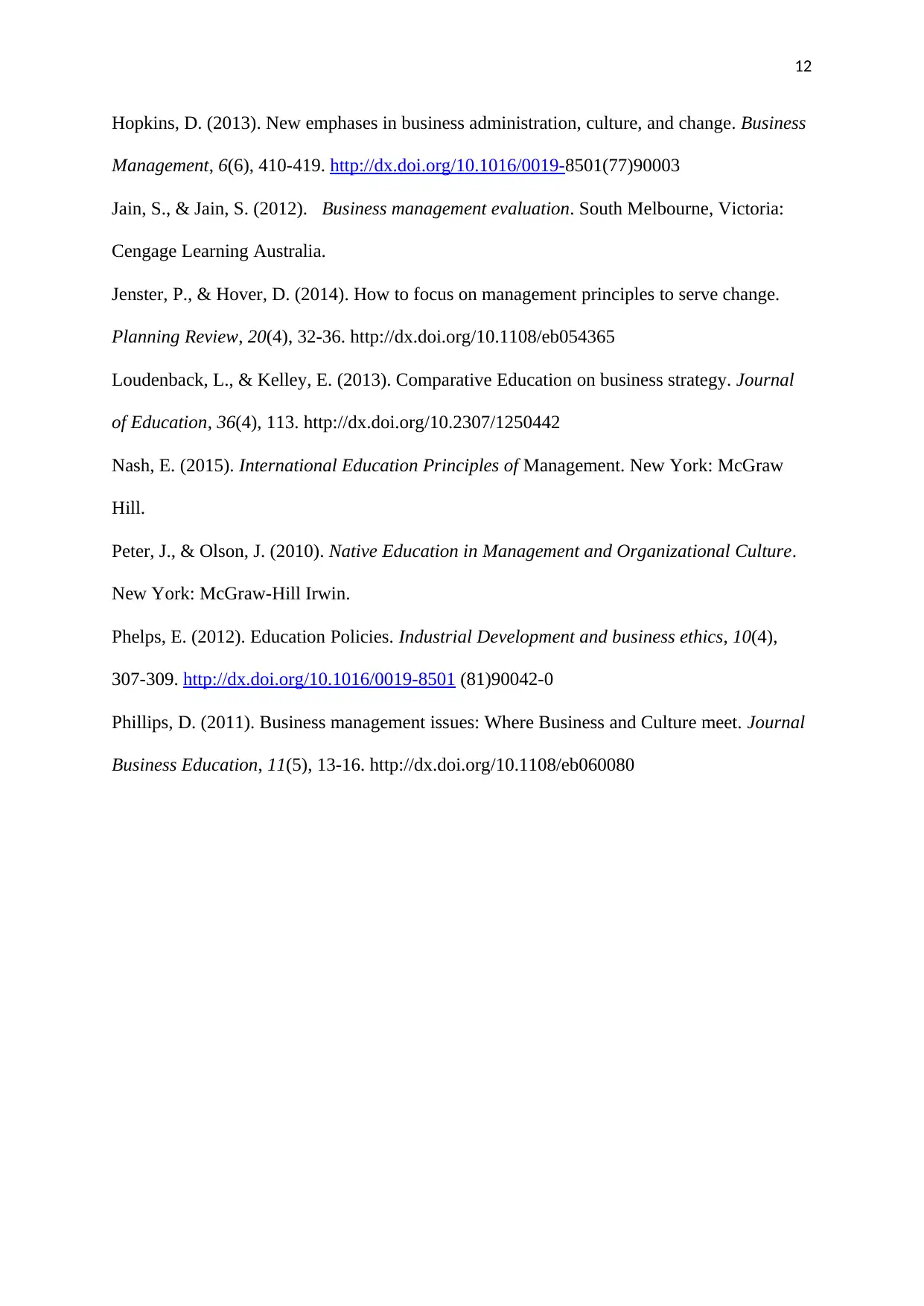
12
Hopkins, D. (2013). New emphases in business administration, culture, and change. Business
Management, 6(6), 410-419. http://dx.doi.org/10.1016/0019-8501(77)90003
Jain, S., & Jain, S. (2012). Business management evaluation. South Melbourne, Victoria:
Cengage Learning Australia.
Jenster, P., & Hover, D. (2014). How to focus on management principles to serve change.
Planning Review, 20(4), 32-36. http://dx.doi.org/10.1108/eb054365
Loudenback, L., & Kelley, E. (2013). Comparative Education on business strategy. Journal
of Education, 36(4), 113. http://dx.doi.org/10.2307/1250442
Nash, E. (2015). International Education Principles of Management. New York: McGraw
Hill.
Peter, J., & Olson, J. (2010). Native Education in Management and Organizational Culture.
New York: McGraw-Hill Irwin.
Phelps, E. (2012). Education Policies. Industrial Development and business ethics, 10(4),
307-309. http://dx.doi.org/10.1016/0019-8501 (81)90042-0
Phillips, D. (2011). Business management issues: Where Business and Culture meet. Journal
Business Education, 11(5), 13-16. http://dx.doi.org/10.1108/eb060080
Hopkins, D. (2013). New emphases in business administration, culture, and change. Business
Management, 6(6), 410-419. http://dx.doi.org/10.1016/0019-8501(77)90003
Jain, S., & Jain, S. (2012). Business management evaluation. South Melbourne, Victoria:
Cengage Learning Australia.
Jenster, P., & Hover, D. (2014). How to focus on management principles to serve change.
Planning Review, 20(4), 32-36. http://dx.doi.org/10.1108/eb054365
Loudenback, L., & Kelley, E. (2013). Comparative Education on business strategy. Journal
of Education, 36(4), 113. http://dx.doi.org/10.2307/1250442
Nash, E. (2015). International Education Principles of Management. New York: McGraw
Hill.
Peter, J., & Olson, J. (2010). Native Education in Management and Organizational Culture.
New York: McGraw-Hill Irwin.
Phelps, E. (2012). Education Policies. Industrial Development and business ethics, 10(4),
307-309. http://dx.doi.org/10.1016/0019-8501 (81)90042-0
Phillips, D. (2011). Business management issues: Where Business and Culture meet. Journal
Business Education, 11(5), 13-16. http://dx.doi.org/10.1108/eb060080
1 out of 12
Related Documents
Your All-in-One AI-Powered Toolkit for Academic Success.
+13062052269
info@desklib.com
Available 24*7 on WhatsApp / Email
![[object Object]](/_next/static/media/star-bottom.7253800d.svg)
Unlock your academic potential
© 2024 | Zucol Services PVT LTD | All rights reserved.





